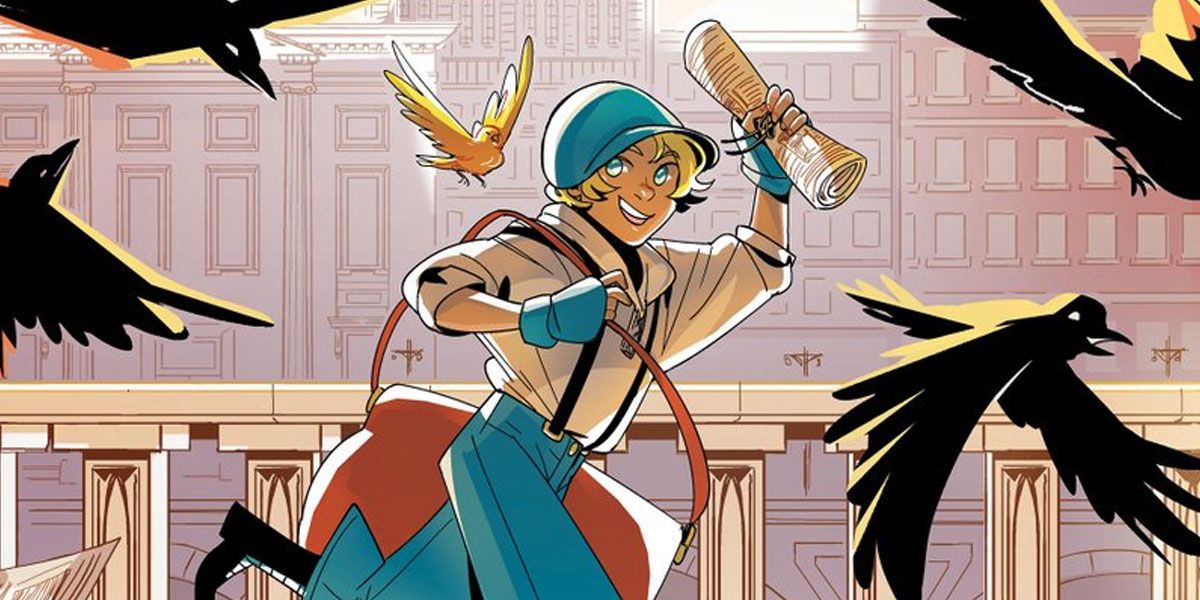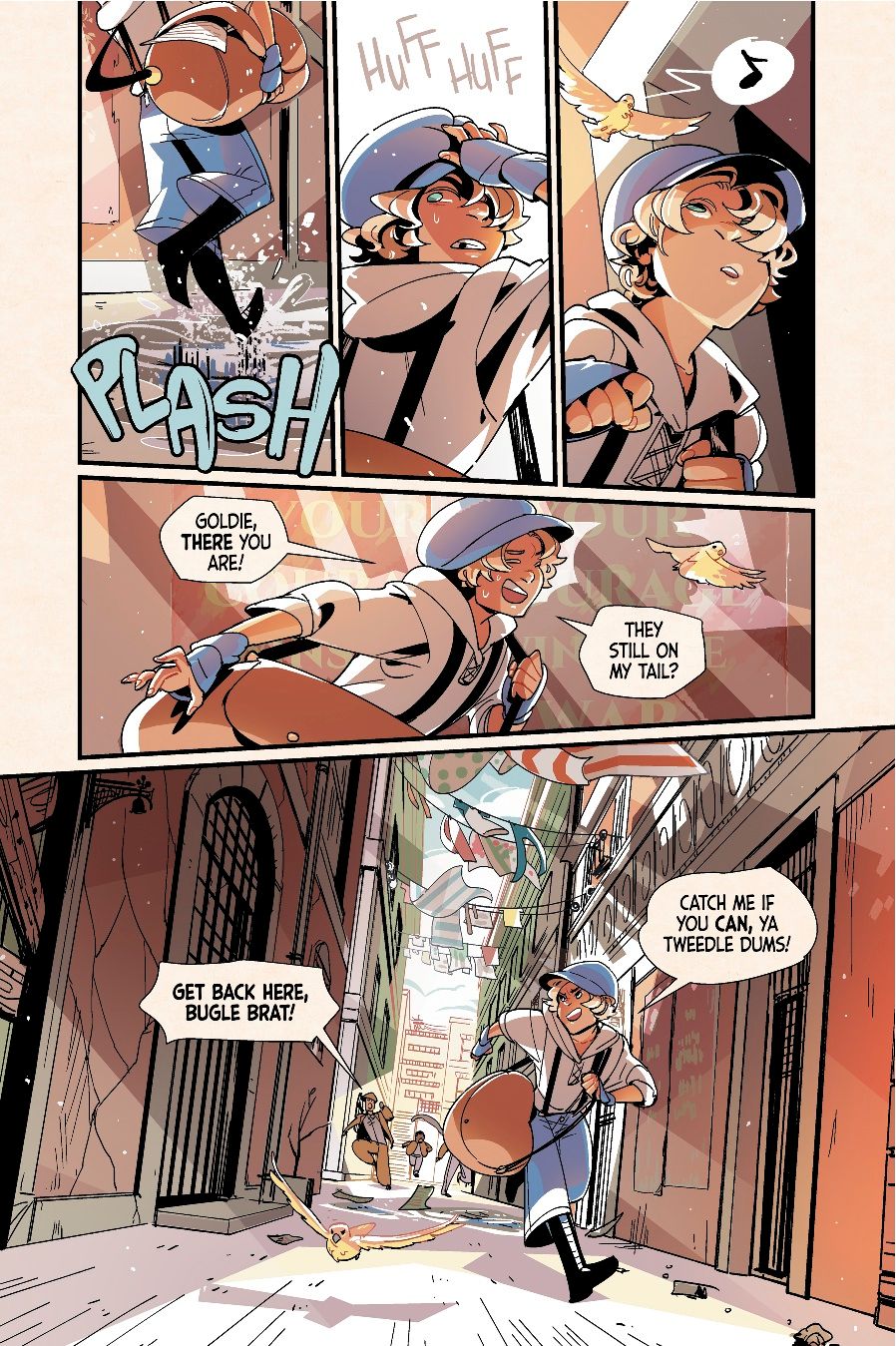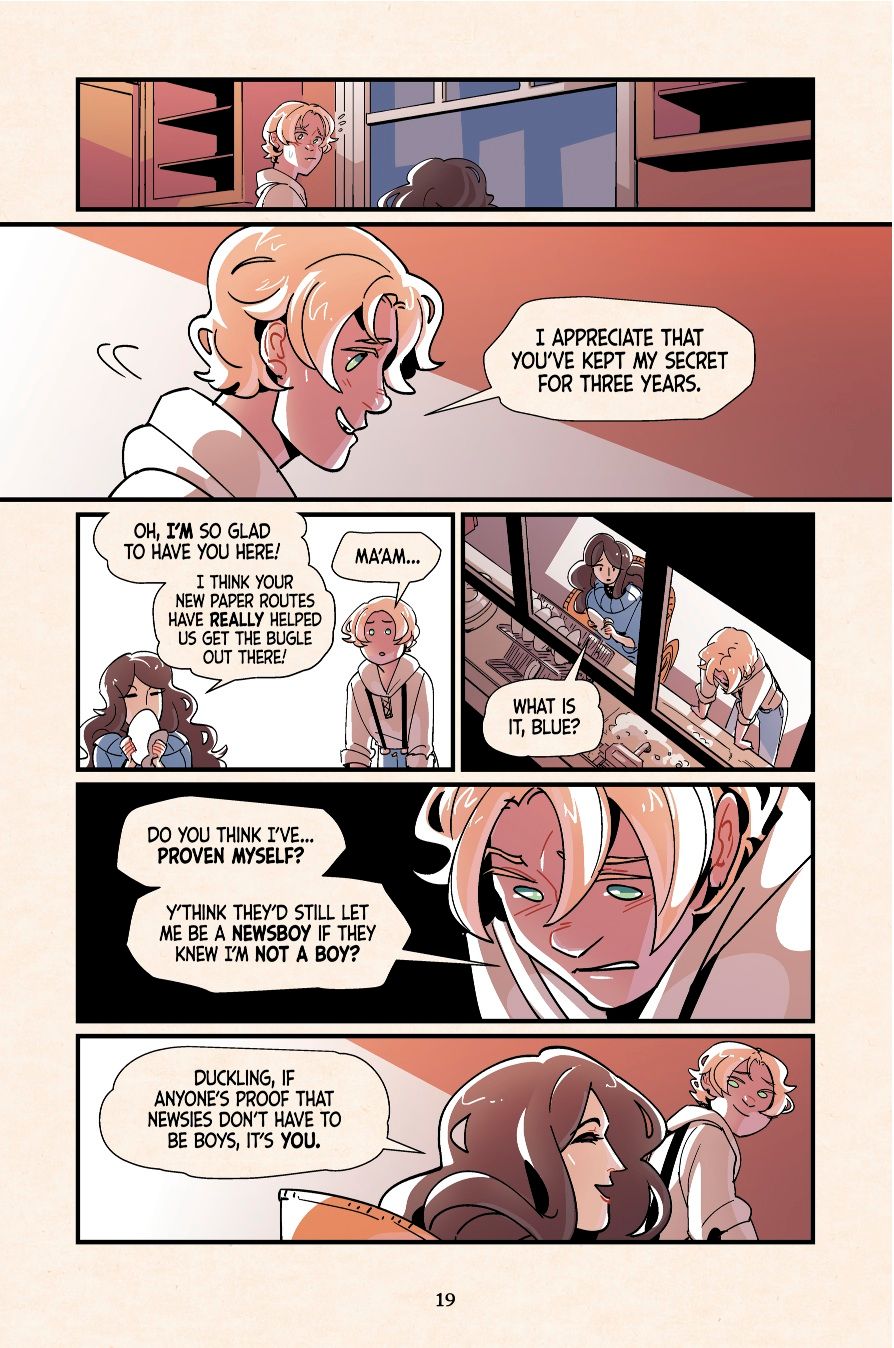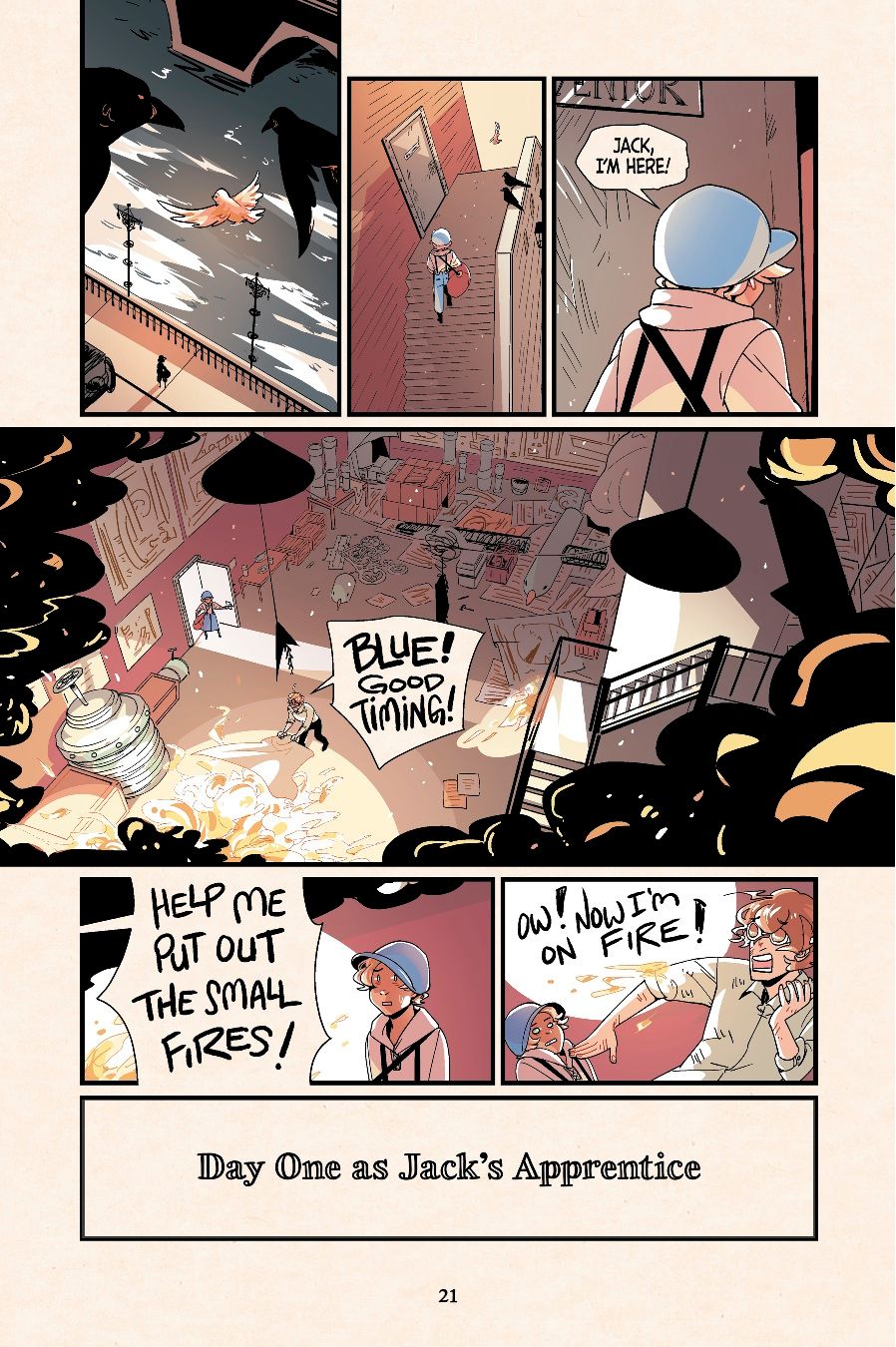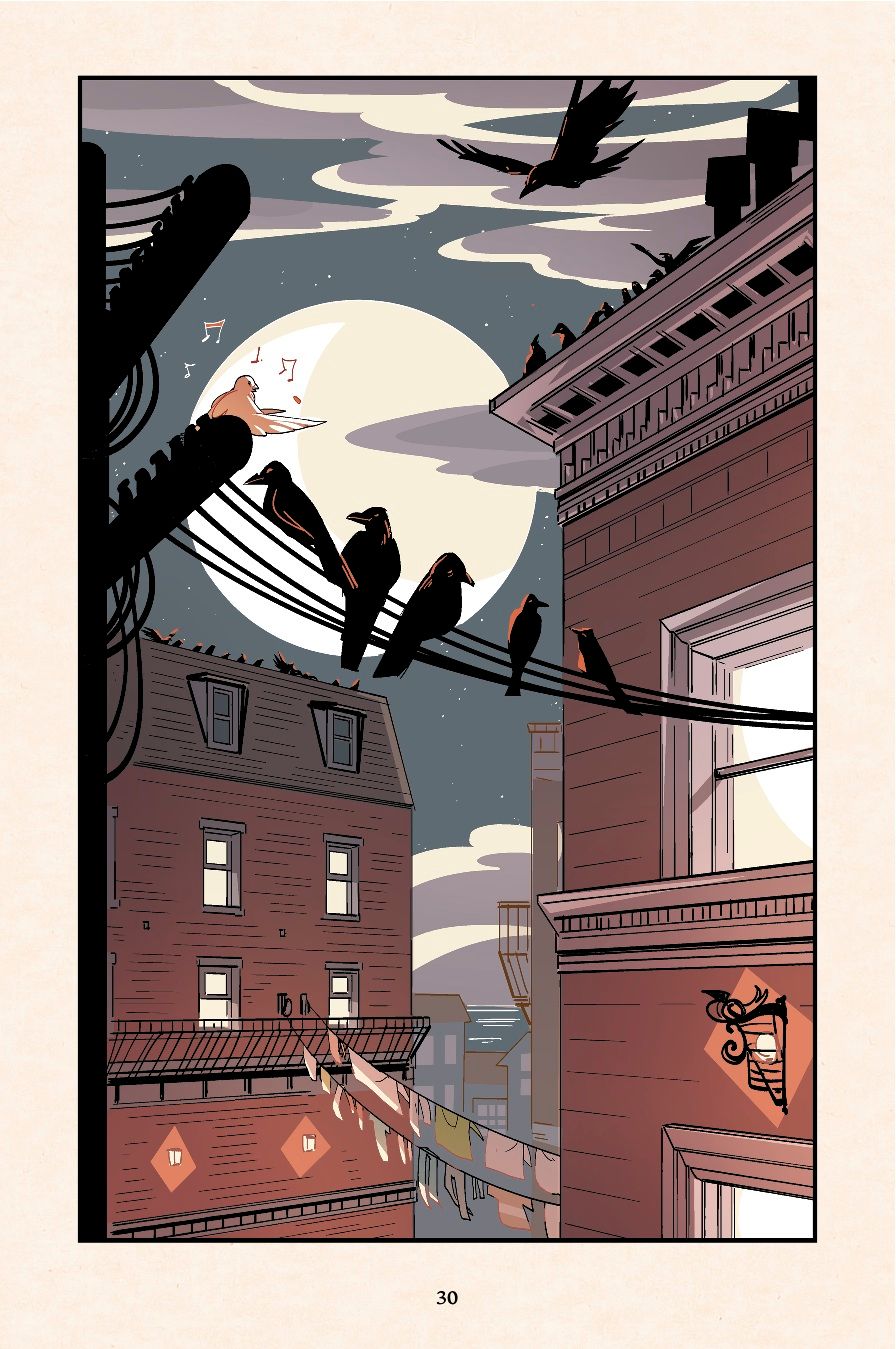Ru Xu is the cartoonist behind the webcomic “Saint for Rent,” a story about an inn for time travelers, but she’s just been introduced to a wider audience with her first graphic novel, “Newsprints,” which was just released by Scholastic’s Graphic imprint. The steampunk/dieselpunk story involves a young girl named Blue, an orphan who pretends to be a boy. She meets a strange boy named Crow and an inventor named Jack, and the war, which seems far away, arrives uncomfortably close to home as Blue has to decide what she believes in and tries to be her true self.
“Newsprints” tells the tale of a girl named Blue who disguises herself as a newsboy in order to work at a newspaper company called The Bugle. It’s a story that encompasses a lot of how I felt growing up – how differently adults treated children depending on their gender and how much of the adult world seems to be so confusing and difficult to grasp as a child. I would say that’s because adults follow their own rules and not necessarily the rules that they teach children.
CBR: As "Newsprints" is set in an alternative steampunk universe in roughly the early 20th Century, where did the aspect of the story that Blue is pretending to be a boy in order to sell newspapers come from?
Ru Xu: “Newsprints” actually started out as characters. I went through several stories before I finally settled on the one I submitted to Scholastic and is now going to be published. Originally, it was a college project. It was supposed to be a PC game where a little kid helped the player character through this strange and crazy emporium to stop the inventor at the very end from destroying the city with his inventions. There’s a kind of whimsical-ness that I think carried the characters through each of the various stories I’ve tried out.
This story is where I went back to my roots of what I really enjoyed as a kid. I read a lot of stories about children uncovering government plots and stories about girls who had to disguise themselves as boys in order to seek their ambitions or do things that they were told were off limits to girls. “Newsprints” became a combination of a lot of things that really spoke to me as a child and I wanted to pass that down.
Who were the characters, besides Blue, that you originally created?
Originally, it was Blue -- except Blue originally had a nebulous gender. Jack was also there. Jack hasn’t changed that much since the very beginning. He was always this red-haired inventor that was a selfish man who pretty much marches to the beat of his own drum. One of the other characters was a woman named Jill who had a very minor role in the very beginning as a flower shop owner, but she eventually turned into more of a supporting character with a bigger role in the story. The character of Crow – the very mysterious boy who Blue meets – he appeared as different birds in different incarnations of the story.
Always a bird?
There was always a bird in the story. I really liked birds since childhood so it was natural for me to make a story where birds was a very central allegory to the story.
It’s interesting you describe Jack in that way, because he plays a role in the book which we’ve seen before in stories but you really show that he does his own thing, which isn’t necessarily positive but more ambiguous and a little selfish.
You have the child world, where being able to do your own thing is great, but even though you gain more autonomy as an adult, in a lot of ways the adult world is very confining. Jack is kind of a giant child. He doesn’t want to follow the same rules as other adults do. Blue found that very admirable at first. The problem was really when Jack lost his nerve and started going back on everything that Blue really admired about him.
At the risk of making the book sound darker than it is, Jack teaches Blue that doing your own thing doesn’t necessarily lead to a better outcome or make you a better person, though she does end the book as she began it – believing that you have to make your own way and hold true to your principles.
It’s true. Maybe Jack didn’t chose the right decision, but at the same time, Blue is a very optimistic character.
Were you thinking in terms of a specific timeframe as you were building the world?
This world is currently in the 1920s. I imagined a world where there was no gap between the First and Second World Wars -- it was just one big war between these two countries in particular. So this is a small part of the world, but Book 2 opens up this fictional world more. I always describe “Newsprints” as diesel punk, but a lot of readers have called it steampunk. I don’t know. Maybe this world is in that transition between coal and diesel?
As you say this is the first book and you’re working on a sequel. How many books do you have planned?
I’m working on a sequel right now, and we’ll see where it goes from there. You’ll have to ask Scholastic.
Did you always see this as, if not a larger story, a story and a world that had the potential to be something larger?
I think so. I put a lot of thought into building the world, so it definitely has the potential to expand into a bigger story across generations of characters – previous generations or future generations.
People who know you are familiar with your webcomic “Saint For Rent.” For people who don’t know, what it is?
“Saint for Rent” is about a guy named Saint who runs a hotel for time travelers. It’s semi-animated in gif format so some of the pages have little animations in the panels. It’s a very nonlinear story because there’s time travel involved and characters go back through time loops to re-live certain events a few different times. It’s a way for me to sort of make time travel a casual slice of life thing.
I think that’s what interesting in your work both in “Saint for Rent” and “Newsprints” is that you like to play with these big concepts and ideas, but you’re primarily interested in people.
It’s always character first for me. I feel like how characters react to these big ideas and events is a more interesting story.
What has been the difference for you between making a book versus making a webcomic?
There seems to be a lot more milestones [with a book]. Just periods of great activity and then no activity, whereas in webcomics it’s very easy to just consistently keep going and making two pages or three pages every week. I always wrote “Saint for Rent” as if it was like a book, but working on a book with Scholastic has been really nice. It’s been really eye opening to see a different method of working – not just a few pages at a time but an entire thumbnail manuscript at a time and then discussing it with my editor and other readers and then moving onto the line art and the colors and so forth.
I thought about doing it black and white. My editor asked if I would consider doing it in color. I considered doing a monotone approach where it was just one color per scene, or in total. Ultimately, I felt like the story would be a lot richer with a richer color platte. It would be a lot more immersive and cinematic and that’s the kind of approach I wanted to have with “Newsprints.” Having a color palette with really strong lighting really helped with that.
There’s a lot of light in the book, which people may not expect given the real world associations we have with cities in that period.
Nautilene, where the story takes place, is a port city. Their main source of income is not industry but trade and even that’s been put on hold a little bit since the war began. I meant for Nautilene to be a bustling port city where the buildings used to be very grand, but now it’s fallen into disarray. The citizens are still very proud of the city and it still has all the qualities of a beautiful city, it’s just been depressed because of the war.
I’m curious, are there any big influences on the book that you can really point to?
This book in particular was heavily influenced by Studio Ghibli’s work. One of the first movies I saw from Studio Ghibli was “Castle in the Sky,” which had a lot of really awesome flying machines. I really enjoyed that aspect along with the lush world building. When I was working on this story and thinking about colors and characters I also was thinking about “The Iron Giant,” which was a movie I really liked. Also I really enjoyed how ambitious “Avatar the Last Airbender” was, not only in its world building but also the scope of the conflict that they tackled in the story. I guess I was just ambitious in wanting to do that myself.
Not to give anything anyway, but at the end of the book, Blue goes off to the nation’s capitol city. As you’re working on the next book, are you conscious of changing the setting and altering the scope?
Absolutely, because not only are they going to Altalus, they’re going to go to Grimmaea in Book 2, so it’s very important to me to be able to create settings that are different from each other but close enough that it looks like they belong in the same world. It’s important to me that the settings are still really interesting no matter where they go so not everywhere is going to look like Nautilene.
But you’re thinking that even if Book 2 doesn’t completely stand on its own storywise – being a sequel – it does need to have it’s own visual identity.
That’s a good way of putting it. I think Book 1 definitely will look very different from Book 2 in a lot of ways – but I can’t be sure until I’m done with Book 2!

